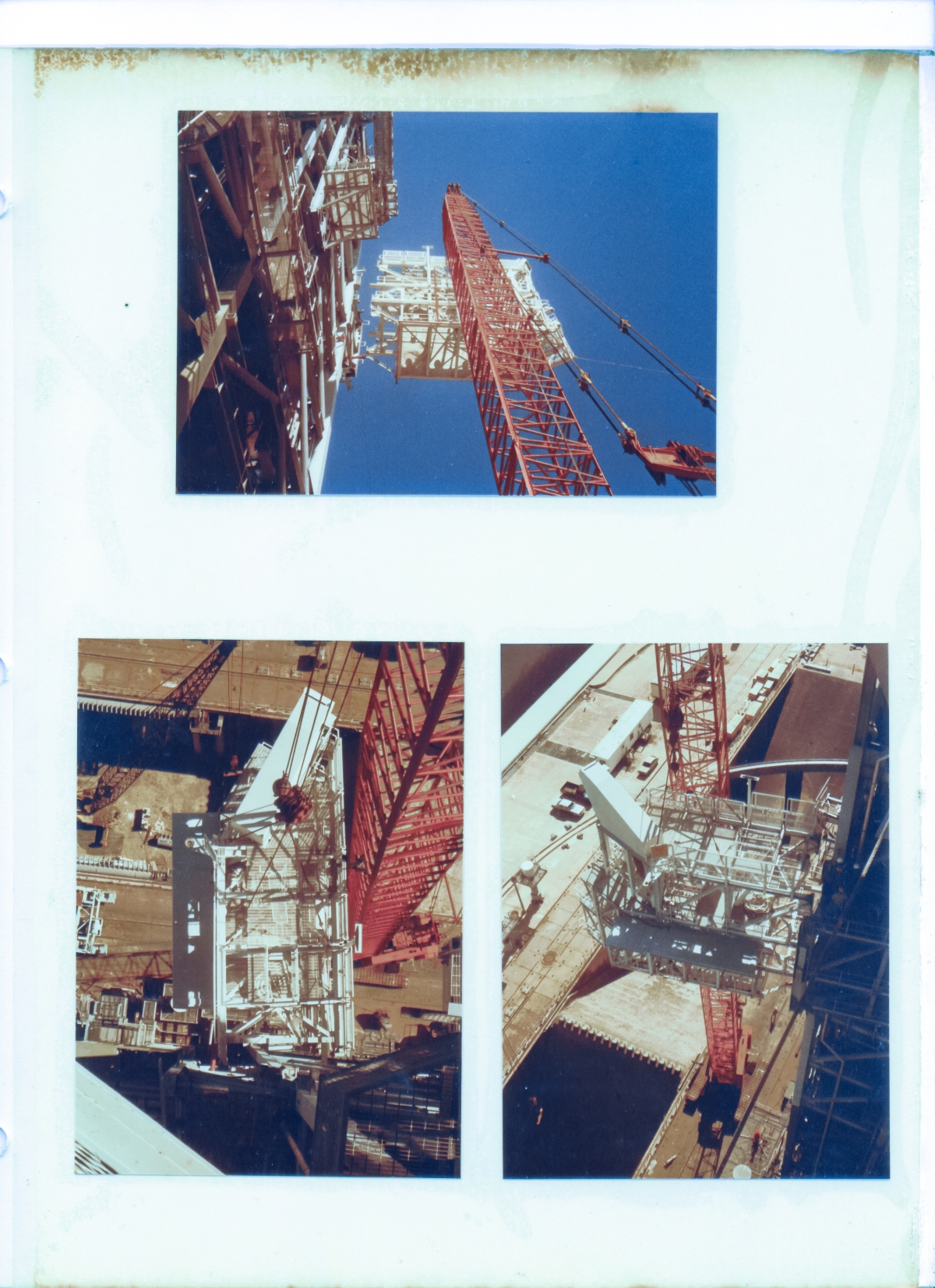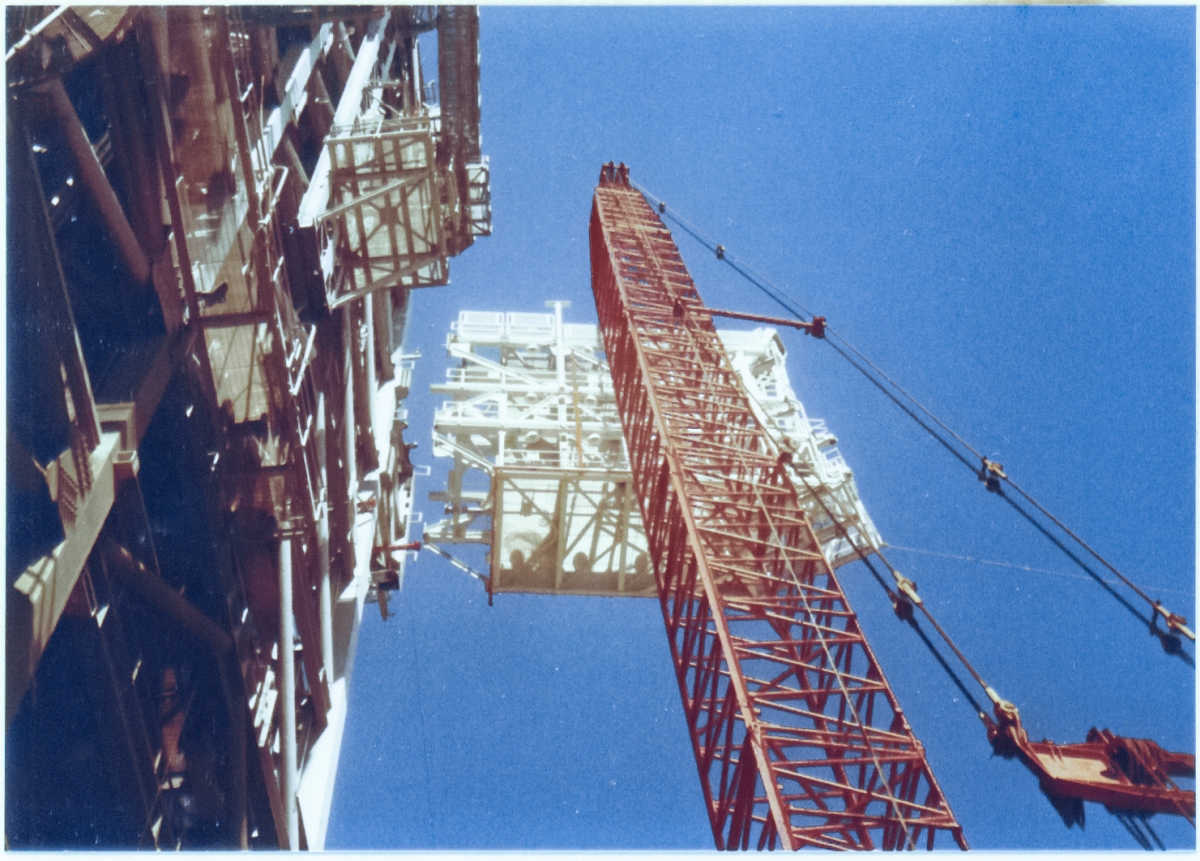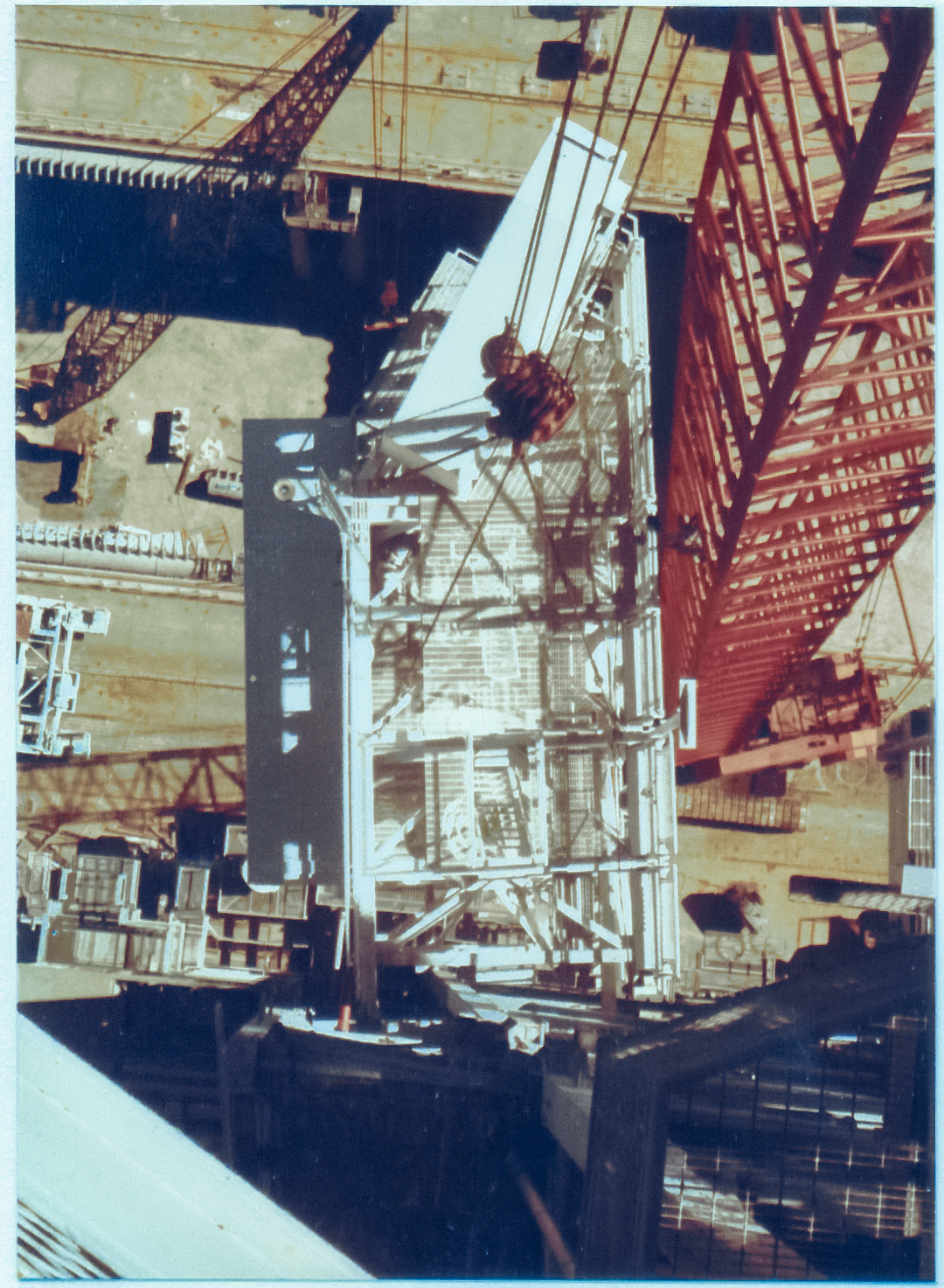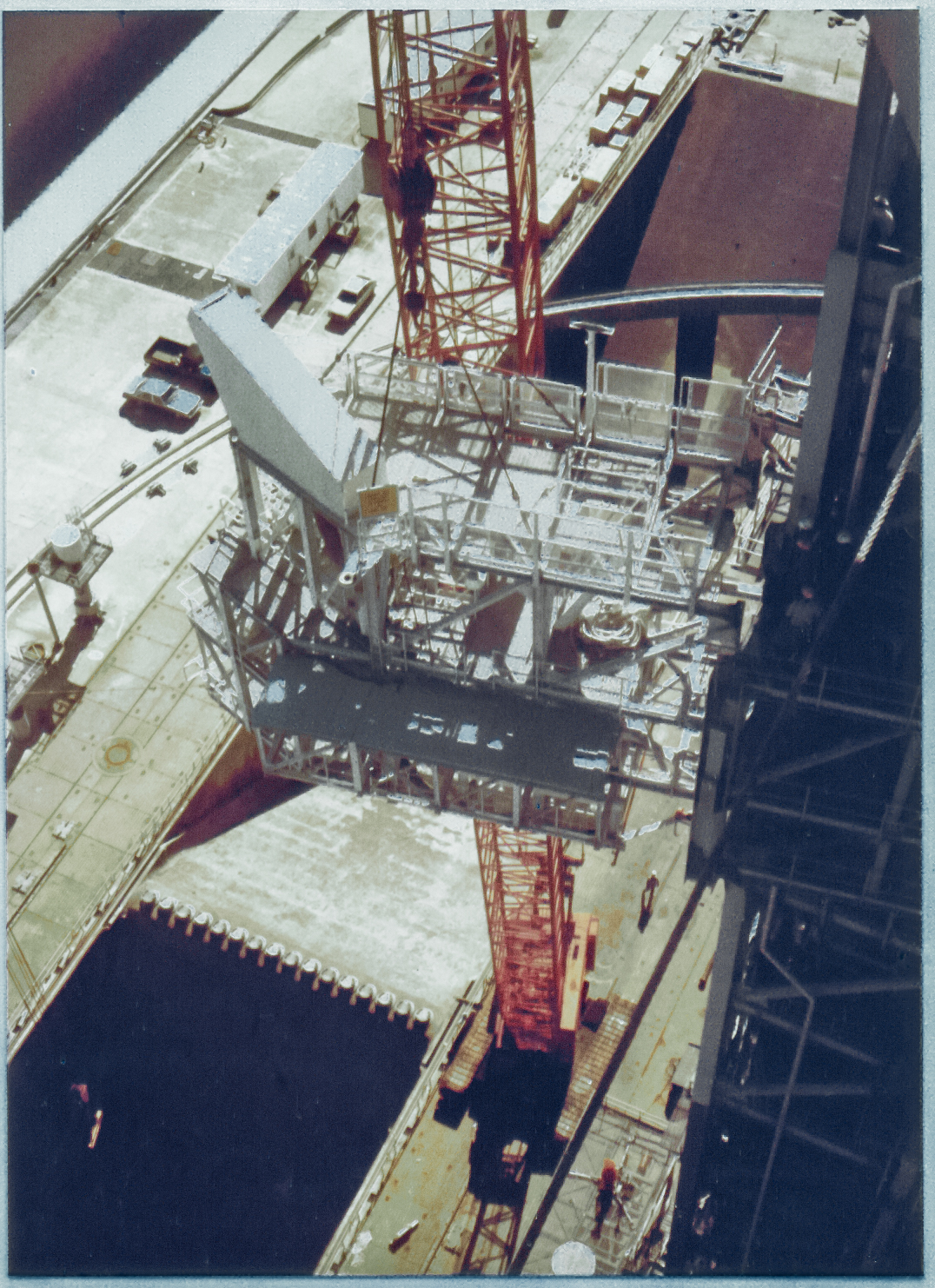Space Shuttle Launch Complex 39-B Construction Photos
Page 19
IAA Lift 2
(Original Scan)
Intertank Access Arm Lift page 2
All of this is pretty much self-explanatory.
The bottom right shot gives a nice view of the Flame Deflector and the south end of the Flame Trench, with cars, trucks, and trailers to give it a bit of scale.
You may also note the curving railway that supports the weight of the RSS as it's rotated into and away from the mate position, supported by a large column that sits in the middle of the slope on the south side of the Flame Trench.
I've skateboarded on the glass-slick surface of the firebricks (burned that way by Saturn V's and Saturn 1-B's) that line the bottom of the Flame Trench, sloping down toward the toe of the Flame Deflector, and that stupid support column always gets in the way, no matter how you try to cut back and avoid it as you switchback down the steep slope. And if you successfully dodge the support column, well then you're going too fast, and you will crash directly in to the more or less waist-high toe of the Flame Deflector before you can get yourself stopped in time.
So skateboarding in the Flame Trench isn't really recommended, ok?
Additional commentary below the image.

Top:
(Reduced)

Well at least I'm not standing directly underneath the lift, this time. There may be hope for me yet. Maybe.
That said, the sight of something this large, this heavy, this improbable-looking, this far up over my head, hanging suspended against the sky..... I dunno. I guess I'm just one of those people, and it will never grow old, never get stale, never become routine no matter how many times I get to watch it. Guilty as charged, your honor.
The beauty, the composition, the otherworldly grace, the symmetry, the tremendous mass of something the size of a small apartment building, and the ever-so-delicately-balanced brute forces required to cause it to float in the sky over your head, the drama, the human element, and on and on and on. I've always taken the position that stuff like this constitutes the very highest level of performance art there is, and make no apologies to anyone, rough-tough construction workers and art professors with an MFA from Otis included, for holding such beliefs.
Give us a nice good zooming in, and look for the ironworkers waiting to make the connection, up on the support steel for the IAA, just left of the IAA itself, on the FSS. I count three heads up there, hanging out over empty space, ready to go hands-on with this thing. Ho hum, just another day at the office, eh?
Bottom Left:
(Full-size)

And now I'm up on the FSS, well above the lift, and this is another one of my favorite shots I ever got out there.
There's a lot going on, and before we get into it, we probably ought to get a look at where I was when I took this shot, to get a better understanding of our point of view, and what we're looking at from there.
So go to this picture please and if you look down toward the bottom right corner, you'll see an unobtrusive little platform sticking out to the right at an angle from the rest of the FSS framing, just above where the Gox arm ties back to the far right side of the FSS, just above the Gox arm hinges.
This little guy was a camera platform, and they were all over the place, on both the FSS and the RSS. This one was just above the second to last platform level on the FSS, which is at an elevation of two-hundred eighty feet above ground level, so with having to walk up a few steps to get on to this platform, plus my own height, holding the camera, I'm guessing we're right around two-hundred ninety feet above ground level.
If you'd like, you can now back out some and take in a full look at the tower, and since you know where this little platform is now, you can get a pretty good idea of exactly where it is in the greater scope of things, complete with the IAA hanging off the side of the FSS in its final location, in this uncropped version of the picture I've referenced just above.
Ok?
Everybody good with where we are?
Very well. Back to what's going on with this picture.
Extreme bottom left corner of the frame shows just a wee little bit of the expanded metal screen that this platform was surrounded with. The screen is welded to a piece of angle-iron that itself is visible, welded down on the top of the platform framing beam, which is also visible, but not by much. So you get a little bit of the sense of just how sturdy this thing was, and in its very exposed position, I'm pretty sure it needed to be that sturdy, because it would take one hell of a beating from the exhaust plume of the left SRB, once the vehicle was sensibly above this elevation, with that exhaust plume expanding outwards and downwards beneath it. This platform was essentially pyroclastic-flow-rated. Volcano-grade stuff. I would imagine that it had the expanded metal screen on it, above and beyond mere handrail, as a way to keep anything that got blown off the camera with its support gear and wiring, from going all the way to the ground, or perhaps getting blown back into the envelope of the FSS at some lower level and hitting a scrubber, or a junction box, or anything else on the tower that might not want to be hit with flying debris or metal. In order to get the view of the lift from above that I wanted, which you're seeing this image, I had to hang out over the side of this camera platform a pretty good ways (no harness, no safety-line, no clip-in, of course), which is why you're getting to see part of it from the outside.
We're outboard of the envelope of the FSS, looking straight down, and you can see the northeast FSS perimeter column extending downwards, starting on the bottom edge of the frame over near the right-hand corner, visible through the steel bar grating of the upper Gox arm hinge access platform and extending toward the the IAA, past the upper IAA support bracket which we'd previously fabricated and installed, and thence on to where it disappears behind the near-side IAA framing member, blocked from further view from there on down to the pad deck.
That steel bar grating is what covered most of the platforms and deck levels on both towers, and is what you encountered at every level when you first exited the FSS elevator, coming up the tower from the nice smooth and solid concrete of the pad deck, and when you walked around on it for the first time ever (and everybody remembers that time), it was a little unnerving, because you could see right through it all the way to the ground, such a long and frightening distance below the soles of your shoes.
Once you got used to it, you never gave it a second thought from then on, and everything was ok. Also, it was incredibly strong and would happily carry some pretty substantial loads without complaint. It was also extraordinarily light for its high load-bearing strength, which meant that you could cover great tracts of floor-space without introducing unpleasant additional burdens upon the supporting structure which held up that floor-space as a result of the additional weight that more normal flooring of an equal bearing strength would introduce into your design and construction particulars.
I'm a big fan of steel bar grating, and as long as you're not wearing high-heeled shoes, you'll be just fine with it too. I never tried high-heel shoes, but I did try barefoot a few times, and although it's doable (or at least doable for somebody with tough feet that goes barefoot more often than they wear shoes) it's more than just a little bit painful and I wouldn't recommend it.
When you're walking around on steel bar grating barefoot, you must be very careful with each step, placing your foot down upon it flat, as opposed to heel-first, in order to sufficiently spread the load of your own weight across enough surface-area of bar-edges such that the bars won't be trying too hard to pass through your skin, into the muscle tissue beneath it. Also, your foot must be traveling vertically, and cannot have any transverse motion as it hits the bars. Those bars came from some mill, somewhere, and no real effort was made to deburr them or to break their sharp edges, and if your foot hits the bars traveling along the direction of their length, they'll probably find a way to slice you up some, and if your foot hits the bars traveling in a direction perpendicular to their length, they'll try to just sort of potato-peeler the skin off of the bottom of your foot. Toes protruding down into the spaces between the bars constitute another issue, and a toe absentmindedly lifted from such a space with too much transverse motion across the bars, and too little attention paid while doing it, will near-instantaneously demonstrate the physics of steel-strength versus bone-strength, and the steel's gonna win that one, every single time. So you walk, very carefully, very slowly, minding each and every footfall, and really it's a crummy way to get somewhere, and why don't you just go put your boots back on and knock it off with this nonsense, ok?
We're looking straight down and the IAA is directly beneath us, and still remains a little bit out of alignment with its support steel and will need to be rotated a bit more, clockwise, from where it is in this image, before the connectors can begin their work of tying it to the FSS.
In the distance, almost two-hundred and fifty feet beneath us and to the right of the IAA, we can see the crawler track and cab of the Manitowoc, with its red boom extending nearly straight up and out of the top of the frame above us.
The main hoist lifting block is visible, partially obscuring the blast hood for the elephant's trunk, and right next to it, you can see the headache ball for the jib line, too.
Left of that, the bottom of the flame trench is visible, almost three hundred feet beneath you. It looks like they're working on the big SSW spray headers that sat near the very top of the flame trench walls on either side, and they've got their own crane down there for that work, which we had nothing to do with. Anything to do with pipes, or anything that carried fluids, was pipefitter work and the ironworkers left it strictly alone, per union rules and agreements. That said, the different crafts were always trying to grab more work, often through the efforts of their business agents and union stewards, and I distinctly recall one time when one of the mechanical contractor's general foreman told me, only half joking, that since the entire RSS was there in part to provide a place to hang platforms and equipment that dealt with water, hypergol, coolant, and cryo, fluids, then the entire RSS should by rights be considered a pipe support and therefore come under the sole purview of the pipefitters, with only pipefitters being allowed to work on it anywhere. I looked at the guy and said nothing in reply. Whatever. Ok. Sure thing, bub.
But the sniping of work never went all the way away, and different parties were ever watchful for who was doing what, and who was authorized to do what, and maybe we can steal this work from these guys if we get creative enough in our reading of the rules and agreements about who's work it really is. It would be amusing, except for the fact that it directly affected a lot of people and their ability to put food on their tables, and how about we don't even get started on the millwrights, ok? The pipefitters were bad enough, thank you very much.
Bottom Right:
(Full-size)

And now we're out on the end of the boom of the hammerhead crane, which has been swung around facing north to keep it out of the way of our crane boom, looking back and down at things.
The IAA remains a little out of alignment, and now, on the FSS framing, you can see, of course, Wade Ivey, with his white hard hat directly in front of the FSS perimeter column, along with three other ironworkers, giving things a good close looking at.
In the far distance, down on the pad deck, the pair of trailers that Boeing's TTV people worked out of can be seen on the far side of the flame trench. The trailer that's partially obscured by the crane boom was the one where Howard Baxter and his closest people worked.
Almost every office out there included some light-hearted, homemade artwork, detailing various aspects of life in an environment like this, and Howard had one on his wall, where someone with more than just a little talent spent more than just a little time rendering a scene in paneled-cartoon format where Howard (who was depicted well, as a short, but very scary-looking looking, rock-solid guy) dealt with a very large and very fierce "Bear In The Woods" which was an incarnation for all of the problems and pitfalls of the project, and in his hand was a cartoonishly outsize wooden club with an even more cartoonishly outsize spike sticking through it near its business end, and the club was labeled as "Howard's Persuader." It had Howard remarking something like "I don't give a goddamn if you're some ol' bear in the woods!" and it did not end well for the bear. That little cartoon was rendered so well, and was so apt, that it has stayed with me a lifetime, and to this day I occasionally find myself using the word persuade in similar fashion. Funny how little things can embed themselves so very deeply into us, sometimes.
From this viewpoint, you can get a pretty good sense of where the flame deflector sat inside the flame trench, as well as the size of it. Fairly substantial object. Took one hell of a beating from the SRB's and the Space Shuttle Main Engines once they lit them up.
I always relished any and all opportunities to get up near the top of the FSS. The view from up there was just too beautiful to describe, and that includes even the industrial-looking things that were going on more or less directly beneath it, which always took on an aspect that I've never really been able to describe or otherwise convey, whenever you viewed them from up here. I tended to dawdle, once I was done with whatever it was that brought me up here, every time, and I neither regret nor apologize for so much as one single minute of that time spent dawdling up there.
Return to 16streets.comACRONYMS LOOK-UP PAGEMaybe try to email me? |